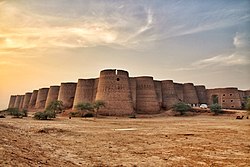Derawar Fort
Derawar Fort (Urdu: قِلعہ ڈیراور; Devanagari: क़िला डेरावर ) is a prominent fortress located in Ahmadpur East Tehsil within the Bahawalpur District of Punjab, Pakistan. Situated approximately 20 kilometers south of the city of Ahmedpur East, the fort's impressive forty bastions can be seen from many miles away across the Cholistan Desert. The fort features walls that have a perimeter of 1,500 meters and rise to a height of up to thirty meters, making it a striking landmark in the region.
| Derawar Fort قِلعہ ڈیراور | |
|---|---|
 | |
| Type | Fortress |
| Location | Ahmadpur East, Bahawalpur, Punjab, Pakistan |
| Coordinates | 28°46′5″N 71°20′3″E / 28.76806°N 71.33417°ECoordinates: 28°46′5″N 71°20′3″E / 28.76806°N 71.33417°E |
| Built | 9th century CE |
| Governing body | Government of Pakistan Pakistan Army |
| Lua error in Module:Location_map at line 526: Unable to find the specified location map definition: "Module:Location map/data/Punjab Pakistan" does not exist. | |
History
The Cholistan Desert is part of the western region of the Thar Desert in modern-day Pakistan, where archaeological evidence indicates that it was once inhabited by the Indus Valley civilisation. This ancient culture thrived due to the presence of the Hakra River, which supported their agricultural lifestyle. However, around 600 BC, the river changed course, leading to its eventual disappearance underground. This shift transformed the area into an arid desert, rendering it unsuitable for human habitation.
Despite the loss of water resources, the region retained its significance as a crucial part of the trade route connecting Central Asia to the India. While the land could no longer sustain settlements, it became an important transit point for merchants and travelers. Among the remnants of this historical period, Derawar Fort stands out as the best-preserved structure, serving as a testament to the area's rich heritage and resilience throughout changing environmental conditions. The fort not only reflects the architectural prowess of its builders but also symbolises the enduring legacy of the civilisations that once flourished in the Cholistan Desert.
Derawar Fort was constructed in 858 CE under the reign of Rai Jajja Bhati, a Hindu Rajput ruler from the Bhati clan. The fort was built as a tribute to Emperor Rawal Deoraj Bhati of the Jaisalmer Royal House, whose capital was situated at Lodhruva. Originally named Dera Rawal, it later evolved into Dera Rawar, and over time, this name transformed into its current pronunciation, Derawar.
The fort is part of a network of fortifications that includes Meergarh, Jaangarh, Marotgarh, Maujgarh, Dingarh, Khangarh, Khairgarh, Bijnotgarh, and Islamgarh. These forts were strategically constructed across the desert to provide shelter for travelers traversing the harsh terrain. Among these structures, Derawar is regarded as the best-preserved example, showcasing the architectural heritage of the region.
In the 18th century, the Muslim Nawabs of Bahawalpur taken over the fort, who belonged to the Shahotra tribe. The fort underwent significant renovations in its current form in 1732 under Nawab Sadeq Muhammad, an Abbasi ruler. However, by 1747, the fort fell from their possession due to the distractions faced by Bahawal Khan in Shikarpur. It was taken by Nawab Mubarak Khan in 1804.
Remarkably, 1,000-year-old catapult shells were discovered among the debris near a decaying wall within the fort, indicating its long history of conflict and defense. Derawar Fort has endured through the centuries primarily due to the consistent population that inhabited the area, which provided the necessary upkeep and maintenance. In contrast, many other medieval structures in the desert deteriorated and collapsed because they lacked a resident community to sustain them, further underscoring the fort's significance as a historical and cultural landmark.
- ↑ Cite error: Invalid
<ref>tag; no text was provided for refs nameddawn